Age Cohort Projections
The Capital District Regional Planning Commission has partnered with RLS Demographics, Inc. to complete age cohort population projections for each county in the Capital Region, in five year increments until 2060. These projections use the 2020 Decennial Census as the base year and include historical data dating back to 1970.
Methodology
Cohort Change Ratios (CCR):
The age cohort population projections were calculated using Cohort Change Ratios (CCR), which is also referred to as the Hamilton-Perry method. CCR is defined as the ratio of the population count of a specific cohort at two different points in time. For example, individuals aged 30-34 in one census are aged 40-44 in the next, allowing the calculation of the CCR by dividing the number of 40-44-year-olds in the later census by the number of 30-34-year-olds in the earlier census. This ratio is then applied to project future population counts.
Open-Ended Categories:
For projections involving open-ended age categories, such as 75+ and 85+, CCRs from earlier decades are used. When CCRs are not available for cohorts born after the last observation, child-women ratios are utilized.
Child Population Projections:
Children aged 0-4 are considered born in the second half of a decade, and those aged 5-9 in the first half. The denominator for the CCR calculation for 0-4-year-olds is the count of women aged 15-39 from the previous decade, and for 5-9-year-olds, it is the count of women aged 20-44 from the previous decade.
Sex Ratio at Birth:
The sex ratio at birth is employed to divide the projected number of newborns by gender.


